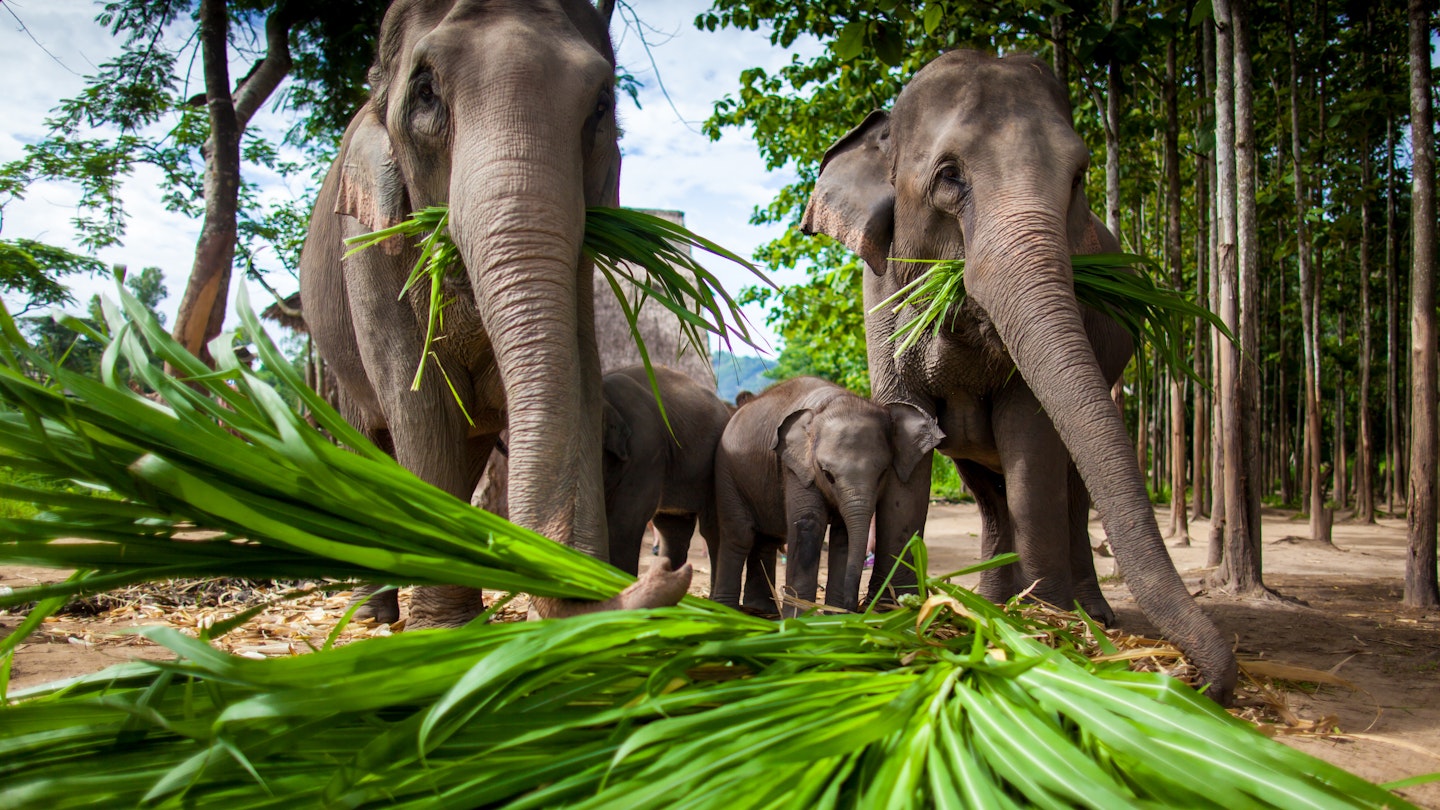Increased awareness of the harm that riding elephants can cause these remarkable animals has led to Thailand’s elephant tourism industry pivoting to offer “gentler” interactions. However, amid claims by animal welfare groups that all interactive experiences can be problematic, a growing number of global tour operators no longer include them on trips. Consequently, what options remain for travelers who want to experience Thailand’s elephants responsibly post-pandemic?
The evolution of Thailand’s elephant industry addresses the understanding that the nation’s long history of using elephants as beasts of burden, and the reverent place of elephants in Thai culture, does not mitigate the harm tourism currently inflicts on these creatures.
The good news is that alternatives now exist to exploitative elephant camps where elephants are forced to perform for tourists’ entertainment. Dotted around Thailand, particularly in the northern hills around Chiang Mai and Chiang Rai, are a growing number of centers for rescued working elephants that offer a chance to encounter these incredible mammals—helping to pay for their upkeep—without causing them harm. Observing elephants up close, but not too close, is an unforgettable experience, especially for families with children.
Understanding Elephant Welfare Issues in Thailand
There was a time when elephant rides or shows with paintings and circus-like performances were commonplace in Thailand. However, this trend is shifting due to amendments to Thai law and growing tourist demand for better welfare practices for captive elephants.
While Thailand has been slow to legislate for elephant protection, improvements are being made. New laws compel owners to provide DNA samples and register elephant births, aiding authorities in monitoring the welfare of Thailand’s estimated 3,800 working elephants.
Despite progress, many elephants in facilities still show signs of anxiety, frustration, or boredom, as revealed by a Chiang Mai University study published in 2021. Moreover, growing consumer awareness, supported by animal welfare groups like World Animal Protection, is pushing elephant camp operators to enhance their standards.
The Changing Face of Elephant Tourism in Thailand
In response to tourist backlash, many elephant camps have ceased offering rides and shows, favoring less intrusive ways to engage with elephants, such as bathing them in rivers and ponds, and feeding them. Some camps now allow elephants to form family groups in large, open enclosures.
While these changes are positive, some animal welfare groups recommend avoiding experiences that involve direct contact with elephants, given the methods used in training.
Many in the global tourism industry have taken note; for instance, in 2019, ABTA, the UK’s largest travel association, updated guidelines to deem it unacceptable for tour operators to offer direct contact with elephants without barriers.
The Impact of COVID-19 on Thailand’s Elephants
The pandemic raised significant concerns for captive elephants, many of whom cannot return to the wild and require ongoing care. By mid-2020, financial challenges led to the closure of numerous camps, leaving thousands of mahouts and staff unemployed.
As a result, organizations like the Save Elephant Foundation have launched campaigns to provide essential food supplies to elephants during this crisis. However, the pandemic has highlighted the risks associated with direct contact and the unsustainability of breeding elephants for tourism.
As tourists gradually return to the Thai Kingdom, it is more crucial than ever to support the ethical treatment of captive elephants. Below are high-welfare elephant tourism options that allow for admiration in a sanctuary-style environment, nearly akin to observing them in the wild.
ChangChill, Chiang Mai
Founded in 2019 with support from World Animal Protection, ChangChill is a pioneer in observation-only elephant tourism. Visitors start with a jungle hike to observe the resident female elephants, followed by relaxation on viewing platforms as the elephants socialize near a stream. This program promotes education about the elephants’ natural behaviors.
Burm & Emily’s Elephant Sanctuary (BEES), Chiang Mai
Established by Emily McWilliam after witnessing the struggles of elephants in tourism, BEES offers a hands-off approach, allowing visitors to observe elephants while participating in sanctuary activities. This model reinforces the importance of ethical tourism.
Boon Lott’s Elephant Sanctuary (BLES), Sukhothai
BLES, founded by Katherine Connor, offers visitors an immersive experience into sanctuary life. Guests participate in daily tasks, such as gathering food and maintaining facilities, further promoting the welfare of elephants.
Following Giants, Ko Lanta
This center, also supported by World Animal Protection, shifted to an observation-only model, encouraging guests to engage in responsible interactions with the elephants in a natural environment.
Phuket Elephant Sanctuary, Phuket
Phuket Elephant Sanctuary allows visitors to observe elephants from a canopy walkway, emphasizing non-intrusive observation. The sanctuary focuses on the care of retired logging elephants and promotes ethical tourism practices.
What to Bring When Visiting an Elephant Center
When planning to visit an elephant center, ensure you wear lightweight, breathable clothing and bring sun protection, insect repellent, sturdy shoes, and any essentials like drinking water in reusable bottles to minimize plastic waste.




